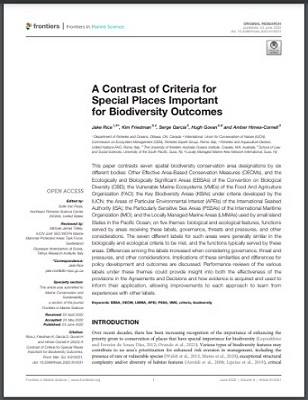
This paper contrasts seven spatial biodiversity conservation area designations by six different bodies: Other Effective Area-Based Conservation Measures (OECMs), and the Ecologically and Biologically Significant Areas (EBSAs) of the Convention on Biological Diversity (CBD); the Vulnerable Marine Ecosystems (VMEs) of the Food And Agriculture Organization (FAO); the Key Biodiversity Areas (KBAs) under criteria developed by the IUCN; the Areas of Particular Environmental Interest (APEIs) of the International Seabed Authority (ISA); the Particularly Sensitive Sea Areas (PSSAs) of the International Maritime Organization (IMO); and the Locally Managed Marine Areas (LMMAs) used by small island States in the Pacific Ocean; on five themes: biological and ecological features, functions served by areas receiving these labels, governance, threats and pressures, and other considerations. The seven different labels for such areas were generally similar in the biologically and ecological criteria to be met, and the functions typically served by these areas. Differences among the labels increased when considering governance, threat and pressures, and other considerations. Implications of these similarities and differences for policy development and outcomes are discussed. Performance reviews of the various labels under these themes could provide insight into both the effectiveness of the provisions in the Agreements and Decisions and how evidence is acquired and used to inform their application, allowing improvements to each approach to learn from experiences with other labels.














